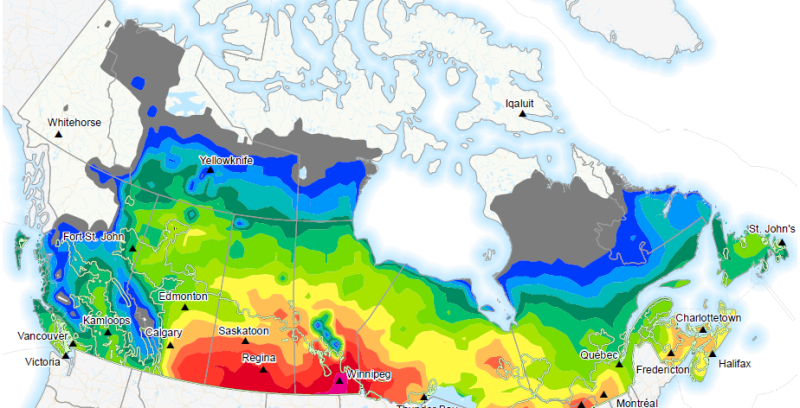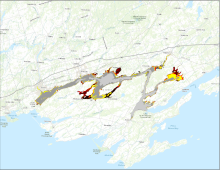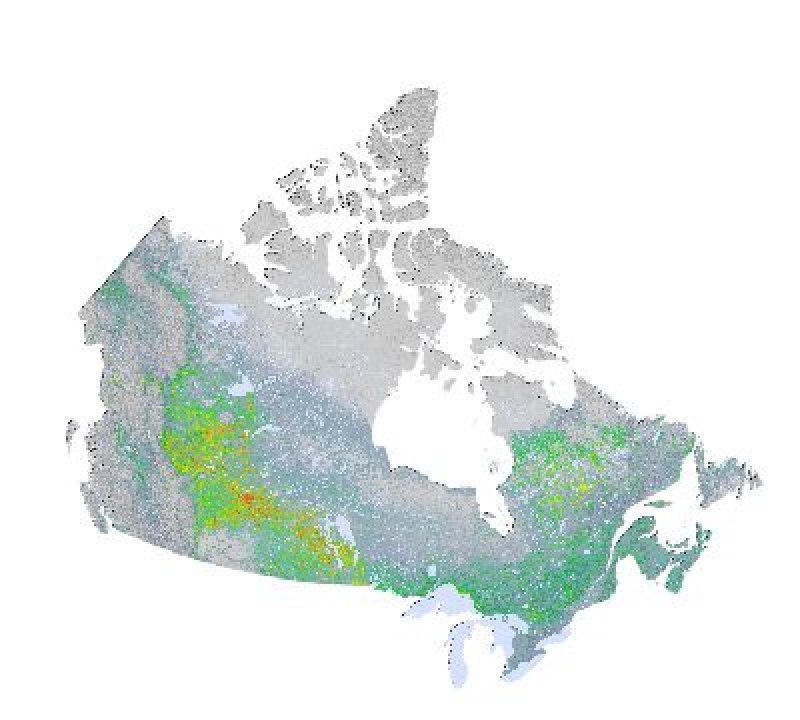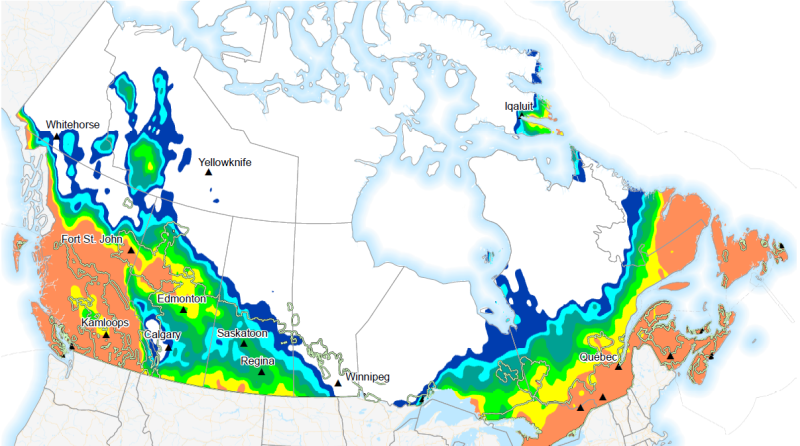GeoTIF
Type of resources
Available actions
Topics
Keywords
Contact for the resource
Provided by
Formats
Representation types
Update frequencies
status
Scale
Resolution
-

The wetland year count data included in this product is national in scope (entire forested ecosystem) and represents a wall to wall wetland characterization for 1984-2016 (Wulder et al. 2018). This product was generated using both annual gap free composite reflectance images and annual forest change maps following the Virtual Land Cover Engine (VLCE) process (see Hermosilla et al. 2018), over the 650 million ha forested ecosystems of Canada. Elements of the VLCE classification approach are inclusion of disturbance information in the processes as well as ensuring class transitions over time are logical. Further, a Hidden Markov Model is implemented to assess individual year class likelihoods to reduce variability and possible noise in year-on-year class assignments (for instances when class likelihoods are similar). The values can range from 0 to 33 denoting the number of years between 1984 and 2016 that a pixel was classified as wetland or wetland-treed in the VLCE data cube. For an overview on the data, image processing, and time series change detection methods applied, as well as information on independent accuracy assessment of the data, see Hermosilla et al. (2016; http://www.tandfonline.com/doi/full/10.1080/17538947.2016.1187673). A detailed description of the VLCE process and the subsequently generated land cover product, including an accuracy assessment, please see Hermosilla et al. (2018). The focused wetland analyses can be found described in Wulder et al (2018). Geographic extent: Canada's forested ecosystems (~ 650 Mha) Time period: 1985–2011
-

The probability of effective growing season degree days above 100 for cool season crops. This condition must be maintained for at least 5 consecutive days in order for EGDD to be accumulated (egdd_cool_100prob). Week 1 and week 2 forecasted probability is available daily from April 1 to October 31. Week 3 and week 4 forecasted probability is available weekly (Thursday) from April 1 to October 31. Cumulative heat-energy satisfies the essential requirement of field crop growth and development towards a high yield and good quality of agricultural crop products. Agriculture and Agri-Food Canada (AAFC) and Environment and Climate Change Canada (ECCC) have together developed a suite of extreme agrometeorological indices based on four main categories of weather factors: temperature, precipitation, heat, and wind. The extreme weather indices are intended as short-term prediction tools and generated using ECCC’s medium range forecasts to create a weekly index product on a daily and weekly basis.
-

Fish Habitat Assessment Output: 12 of 16 Average Water Level (75.0m ASL) - Nursery Habitat - Low Vegetation Association Species (All Temperature Windows) Habitat suitability was assessed for the Bay of Quinte Area of Concern, at a 3 m grid resolution, using the Habitat Ecosystem Assessment Tool (HEAT), temperature algorithms, vegetation models, and water level input. Habitat classifications were based on three variables: depth (elevation), vegetation, and substrate; and modified by temperature suitabilities. The final suitability maps were based on documented habitat and temperature associations for the fish in the area. Different life stages (spawning requirements, nursery habitat, adult habitat) were modeled for the years of 1972-2011. Suitability values were scaled from 0 (not suitable) to 1 (highly suitable) and converted to suitability classes of very low, low, medium, and high. The final maps for each guild – life stage combination are maximum suitability values from the 39-year period modelled.
-

Fish Habitat Assessment Output: 9 of 16 Average Water Level (75.0m ASL) - Spawning Habitat - High Vegetation Association Species (All Temperature Windows) Habitat suitability was assessed for the Bay of Quinte Area of Concern, at a 3 m grid resolution, using the Habitat Ecosystem Assessment Tool (HEAT), temperature algorithms, vegetation models, and water level input. Habitat classifications were based on three variables: depth (elevation), vegetation, and substrate; and modified by temperature suitabilities. The final suitability maps were based on documented habitat and temperature associations for the fish in the area. Different life stages (spawning requirements, nursery habitat, adult habitat) were modeled for the years of 1972-2011. Suitability values were scaled from 0 (not suitable) to 1 (highly suitable) and converted to suitability classes of very low, low, medium, and high. The final maps for each guild – life stage combination are maximum suitability values from the 39-year period modelled.
-

Fish Habitat Assessment Output: 7 of 16 High Water Level (75.4m ASL) - Juvenile/Adult Habitat - Low Vegetation Association Species (Coolwater Guild) Habitat suitability was assessed for the Bay of Quinte Area of Concern, at a 3 m grid resolution, using the Habitat Ecosystem Assessment Tool (HEAT), temperature algorithms, vegetation models, and water level input. Habitat classifications were based on three variables: depth (elevation), vegetation, and substrate; and modified by temperature suitabilities. The final suitability maps were based on documented habitat and temperature associations for the fish in the area. Different life stages (spawning requirements, nursery habitat, adult habitat) were modeled for the years of 1972-2011. Suitability values were scaled from 0 (not suitable) to 1 (highly suitable) and converted to suitability classes of very low, low, medium, and high. The final maps for each guild – life stage combination are maximum suitability values from the 39-year period modelled.
-

Fish Habitat Assessment Output: 10 of 16 Average Water Level (75.0m ASL) - Spawning Habitat - Low Vegetation Association Species (All Temperature Windows) Habitat suitability was assessed for the Bay of Quinte Area of Concern, at a 3 m grid resolution, using the Habitat Ecosystem Assessment Tool (HEAT), temperature algorithms, vegetation models, and water level input. Habitat classifications were based on three variables: depth (elevation), vegetation, and substrate; and modified by temperature suitabilities. The final suitability maps were based on documented habitat and temperature associations for the fish in the area. Different life stages (spawning requirements, nursery habitat, adult habitat) were modeled for the years of 1972-2011. Suitability values were scaled from 0 (not suitable) to 1 (highly suitable) and converted to suitability classes of very low, low, medium, and high. The final maps for each guild – life stage combination are maximum suitability values from the 39-year period modelled.
-

Fish Habitat Assessment Output: 11 of 16 Average Water Level (75.0m ASL) - Nursery Habitat - High Vegetation Association Species (All Temperature Windows) Habitat suitability was assessed for the Bay of Quinte Area of Concern, at a 3 m grid resolution, using the Habitat Ecosystem Assessment Tool (HEAT), temperature algorithms, vegetation models, and water level input. Habitat classifications were based on three variables: depth (elevation), vegetation, and substrate; and modified by temperature suitabilities. The final suitability maps were based on documented habitat and temperature associations for the fish in the area. Different life stages (spawning requirements, nursery habitat, adult habitat) were modeled for the years of 1972-2011. Suitability values were scaled from 0 (not suitable) to 1 (highly suitable) and converted to suitability classes of very low, low, medium, and high. The final maps for each guild – life stage combination are maximum suitability values from the 39-year period modelled.
-

Canada's National Forest Inventory (NFI) sampling program is designed to support reporting on forests at the national scale. On the other hand, continuous maps of forest attributes are required to support strategic analyses of regional policy and management issues. We have therefore produced maps covering 4.03 × 106 km2 of inventoried forest area for the 2001 base year using standardised observations from the NFI photo plots (PP) as reference data. We used the k nearest neighbours (kNN) method with 26 geospatial data layers including MODIS spectral data and climatic and topographic variables to produce maps of 127 forest attributes at a 250 × 250 m resolution. The stand-level attributes include land cover, structure, and tree species relative abundance. In this article, we report only on total live aboveground tree biomass, with all other attributes covered in the supplementary data (http://nrcresearchpress.com/doi/suppl/10.1139/cjfr-2013-0401). In general, deviations in predicted pixel-level values from those in a PP validation set are greater in mountainous regions and in areas with either low biomass or sparse PP sampling. Predicted pixel-level values are overestimated at small observed values and underestimated at large ones. Accuracy measures are improved through the spatial aggregation of pixels to 1 km2 and beyond. Overall, these new products provide unique baseline information for strategic-level analyses of forests (https://nfi.nfis.org) Collection: - **[Canada's National Forest Inventory (NFI) 2006](https://open.canada.ca/data/en/dataset/e2fadaeb-3106-4111-9d1c-f9791d83fbf4)**
-
This data publication contains two collections of raster maps of forest attributes across Canada, the first collection for year 2001, and the second for year 2011. The 2001 collection is actually an improved version of an earlier set of maps produced also for year 2001 (Beaudoin et al 2014, DOI: https://doi.org/10.1139/cjfr-2013-0401) that is itself available through the web site “http://nfi-nfis.org”. Each collection contains 93 maps of forest attributes: four land cover classes, 11 continuous stand-level structure variables such as age, volume, biomass and height, and 78 continuous values of percent composition for tree species or genus. The mapping was done at a spatial resolution of 250m along the MODIS grid. Briefly the method uses forest polygon information from the first version of photoplots database from Canada’s National Forest Inventory as reference data, and the non-parametric k-nearest neighbors procedure (kNN) to create the raster maps of forest attributes. The approach uses a set of 20 predictive variables that include MODIS spectral reflectance data, as well as topographic and climate data. Estimates are carried out on target pixels across all Canada treed landmass that are stratified as either forest or non-forest with 25% forest cover used as a threshold. Forest cover information was extracted from the global forest cover product of Hansen et al (2013) (DOI: https://doi.org/10.1126/science.1244693). The mapping methodology and resultant datasets were intended to address the discontinuities across provincial borders created by their large differences in forest inventory standards. Analysis of residuals has failed to reveal residual discontinuities across provincial boundaries in the current raster dataset, meaning that our goal of providing discontinuity-free maps has been reached. The dataset was developed specifically to address strategic issues related to phenomena that span multiple provinces such as fire risk, insect spread and drought. In addition, the use of the kNN approach results in the maintenance of a realistic covariance structure among the different variable maps, an important property when the data are extracted to be used in models of ecosystem processes. For example, within each pixel, the composition values of all tree species add to 100%. * Details on the product development and validation can be found in the following publication: Beaudoin, A., Bernier, P.Y., Villemaire, P., Guindon, L., Guo, X.-J. 2017. Tracking forest attributes across Canada between 2001 and 2011 using a kNN mapping approach applied to MODIS imagery, Canadian Journal of Forest Research 48: 85–93. DOI: https://doi.org/10.1139/cjfr-2017-0184 * Please cite this dataset as: Beaudoin A, Bernier PY, Villemaire P, Guindon L, Guo XJ. 2017. Species composition, forest properties and land cover types across Canada’s forests at 250m resolution for 2001 and 2011. Natural Resources Canada, Canadian Forest Service, Laurentian Forestry Centre, Quebec, Canada. https://doi.org/10.23687/ec9e2659-1c29-4ddb-87a2-6aced147a990 * This dataset contains these NFI forest attributes: ## LAND COVER : landbase vegetated, landbase non-vegetated, landcover treed, landcover non-treed ## TREE STRUCTURE : total above ground biomass, tree branches biomass, tree foliage biomass, stem bark biomass, stem wood biomass, total dead trees biomass, stand age, crown closure, tree stand heigth, merchantable volume, total volume ## TREE SPECIES : abies amabilis (amabilis fir), abies balsamea (balsam fir), abies lasiocarpa (subalpine fir), abies spp. (unidentified fir), acer macrophyllum (bigleaf maple), acer negundo (manitoba maple, box-elder), acer pensylvanicum (striped maple), acer rubrum (red maple), acer saccharinum (silver maple), acer saccharum (sugar maple), acer spicatum (mountain maple), acer spp. (unidentified maple), alnus rubra (red alder), alnus spp. (unidentified alder), arbutus menziesii (arbutus), betula alleghaniensis (yellow birch), betula papyrifera (white birch), betula populifolia (gray birch), betula spp. (unidentified birch), carpinus caroliniana (blue-beech), carya cordiformis (bitternut hickory), chamaecyparis nootkatensis (yellow-cedar), fagus grandifolia (american beech), fraxinus americana (white ash), fraxinus nigra (black ash), fraxinus pennsylvanica (red ash), juglans cinerea (butternut), juglans nigra (black walnut), juniperus virginiana (eastern redcedar), larix laricina (tamarack), larix lyallii (subalpine larch), larix occidentalis (western larch), larix spp. (unidentified larch), malus spp. (unidentified apple), ostrya virginiana (ironwood, hop-hornbeam), picea abies (norway spruce), picea engelmannii (engelmann spruce), picea glauca (white spruce), picea mariana (black spruce), picea rubens (red spruce), picea sitchensis (sitka spruce), picea spp. (unidentified spruce), pinus albicaulis (whitebark pine), pinus banksiana (jack pine), pinus contorta (lodgepole pine), pinus monticola (western white pine), pinus ponderosa (ponderosa pine), pinus resinosa (red pine), pinus spp. (unidentified pine), pinus strobus (eastern white pine), pinus sylvestris (scots pine), populus balsamifera (balsam poplar), populus grandidentata (largetooth aspen), populus spp. (unidentified poplar), populus tremuloides (trembling aspen), populus trichocarpa (black cottonwood), prunus pensylvanica (pin cherry), prunus serotina (black cherry), pseudotsuga menziesii (douglas-fir), quercus alba (white oak), quercus macrocarpa (bur oak), quercus rubra (red oak), quercus spp. (unidentified oak), salix spp. (unidentified willow), sorbus americana (american mountain-ash), thuja occidentalis (eastern white-cedar), thuja plicata (western redcedar), tilia americana (basswood), tsuga canadensis (eastern hemlock), tsuga heterophylla (western hemlock), tsuga mertensiana (mountain hemlock), tsuga spp. (unidentified hemlock), ulmus americana (white elm), unidentified needleaf, unidentified broadleaf, broadleaf species, needleaf species, unknown species
-

Probability of daily precipitation above 25mm over the forecast period (p1d25_prob). Week 1 and week 2 forecasted probability is available daily from September 1 to August 31. Week 3 and week 4 forecasted probability is available weekly (Thursday) from September 1 to August 31. Units: mm Precipitation (moisture availability) establishes the economic yield potential and product quality of field crops. Both dry and wet precipitation extremes have the ability to inhibit proper crop growth. The greatest daily precipitation index covers the risk of excessive precipitation in the short term, while the other indices pertain to longer term moisture availability. Agriculture and Agri-Food Canada (AAFC) and Environment and Climate Change Canada (ECCC) have together developed a suite of extreme agrometeorological indices based on four main categories of weather factors: temperature, precipitation, heat, and wind. The extreme weather indices are intended as short-term prediction tools and generated using ECCC’s medium range forecasts to create a weekly index product on a daily and weekly basis.
 Arctic SDI catalogue
Arctic SDI catalogue